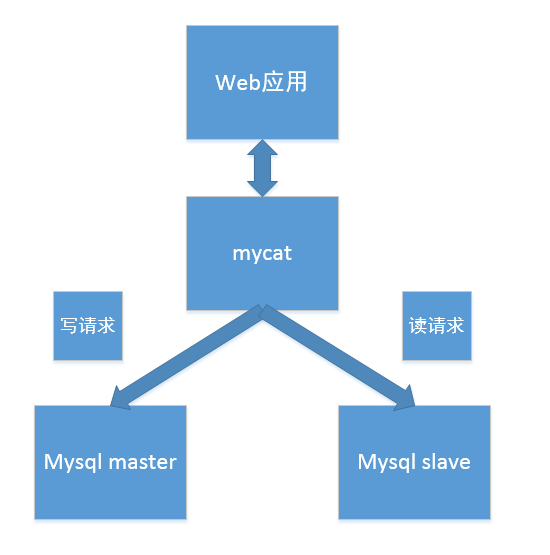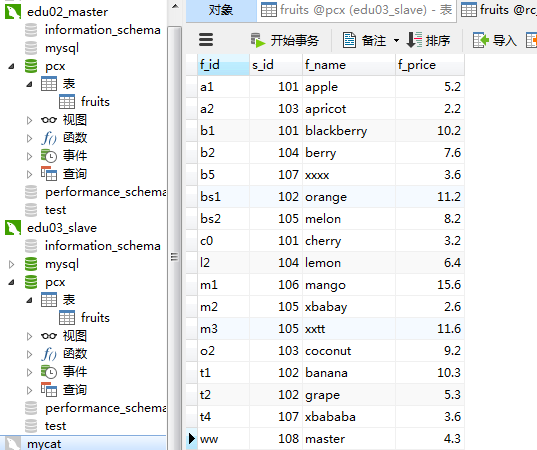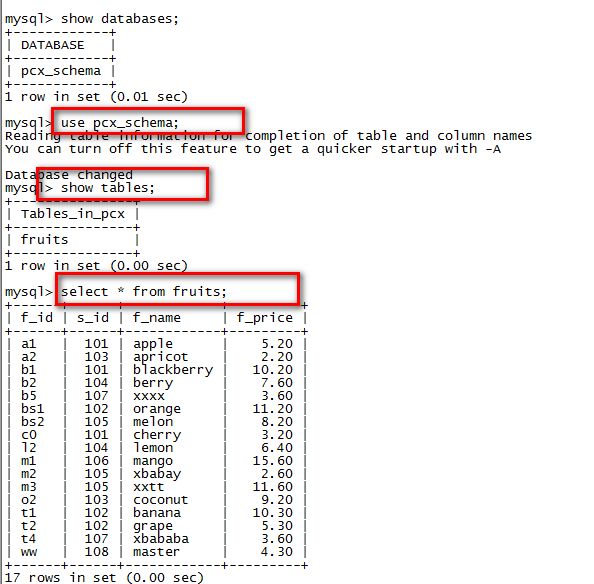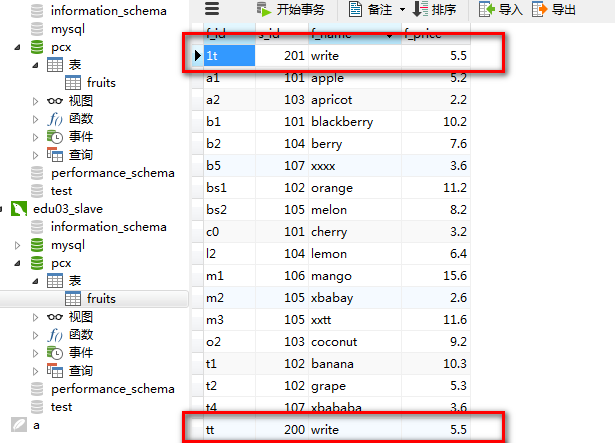用mycat做读写分离:基于 MySQL主从复制
2017-09-07 10:42
911 查看
mycat是最近很火的一款国人发明的分布式数据库中间件,它是基于阿里的cobar的基础上进行开发的
搭建之前我们先要配置mysql的主从复制,这个过程很长,我这里就不写了,有兴趣的可以看看我写的这篇文章。
linux centos下mysql数据库的主从复制环境搭建
mycat在应用当中的作用可以看下图

mycat可以让程序员只需要关心业务代码的编写,而不用担心后端数据库集群的负载均衡,读写分离,分库分表的数据分片逻辑的编写,只要直接连接mycat就可以了
首先我们准备一台干净的centos机器,安装好jdk

解压mycat的安装包到/user/local/下

设置mycat的环境变量
[html] view plain copy print?vi /etc/profile

使配置文件立即生效
[html] view plain copy print?source /etc/profile
进入mycat的配置文件目录
[html] view plain copy print?cd /usr/local/mycat/conf/
这个配置文件主要是用来配置数据库节点,逻辑表等等东西的
[html] view plain copy print?<?xml version=“1.0”?>
<!DOCTYPE mycat:schema SYSTEM “schema.dtd”>
<mycat:schema xmlns:mycat=“http://org.opencloudb/”>
<!– 定义MyCat的逻辑库 –>
<schema name=“pcx_schema” checkSQLschema=“false” sqlMaxLimit=“100” dataNode=“pcxNode”></schema>
<!– 定义MyCat的数据节点 –>
<dataNode name=“pcxNode” dataHost=“dtHost” database=“pcx” />
<!– 定义数据主机dtHost,连接到MySQL读写分离集群 ,schema中的每一个dataHost中的host属性值必须唯一–>
<!– dataHost实际上配置就是后台的数据库集群,一个datahost代表一个数据库集群 –>
<!– balance=”1”,全部的readHost与stand by writeHost参与select语句的负载均衡–>
<!– writeType=”0”,所有写操作发送到配置的第一个writeHost,这里就是我们的hostmaster,第一个挂了切到还生存的第二个writeHost–>
<dataHost name=“dtHost” maxCon=“500” minCon=“20” balance=“1”
writeType=“0” dbType=“mysql” dbDriver=“native” switchType=“2” slaveThreshold=“100”>
<!–心跳检测 –>
<heartbeat>show slave status</heartbeat>
<!–配置后台数据库的IP地址和端口号,还有账号密码 –>
<writeHost host=“hostMaster” url=“192.168.1.6:3306” user=“root” password=“root” />
<writeHost host=“hostSlave” url=“192.168.1.7:3306” user=“root” password=“root” />
</dataHost>
</mycat:schema>
[html] view plain copy print?vi server.xml
<!– - - Licensed under the Apache License, Version 2.0 (the “License”);
- you may not use this file except in compliance with the License. - You
may obtain a copy of the License at - - http://www.apache.org/licenses/LICENSE-2.0 - - Unless required by applicable law or agreed to in writing, software -
distributed under the License is distributed on an “AS IS” BASIS, - WITHOUT
WARRANTIES OR CONDITIONS OF ANY KIND, either express or implied. - See the
License for the specific language governing permissions and - limitations
under the License. –>
<!DOCTYPE mycat:server SYSTEM “server.dtd”>
<mycat:server xmlns:mycat=“http://org.opencloudb/”>
<system>
<!– 这里配置的都是一些系统属性,可以自己查看mycat文档 –>
<property name=“defaultSqlParser”>druidparser</property>
<property name=“charset”>utf8mb4</property>
</system>
<!– 用户1,对应的MyCat逻辑库连接到的数据节点对应的主机为主从复制集群 –>
<user name=“user1”>
<property name=“password”>root</property>
<property name=“schemas”>pcx_schema</property>
</user>
<!– 用户2,只读权限–>
<user name=“user2”>
<property name=“password”>root</property>
<property name=“schemas”>pcx_schema</property>
<property name=“readOnly”>true</property>
</user>
</mycat:server>
[html] view plain copy print?vi /etc/sysconfig/iptables
-A INPUT -m state –state NEW -m tcp -p tcp –dport 9066 -j ACCEPT
然后重启防火墙
[html] view plain copy print?service iptables restart
[html] view plain copy print?cd /usr/local/mycat/bin/
进入mycat的脚本目录

运行启动命令
[html] view plain copy print?./mycat start
我们可以使用mysql客户端连接或者navicat来连接mycat


接下来我们测试一下读写分离
进入mycat的日志目录
[html] view plain copy print?cd /usr/local/mycat/logs/

先测试一下读操作
我们连接到mycat发送一句select *命令试试


可以看到select 操作被路由到了192.168.1.7也就是我们的slave节点
那么我们执行多次看看

结果还是被路由到了读节点
接下来我们测试一下写操作


可见插入被路由到了master节点
最后我们看看master的数据是否被同步到slave

记录成功的同步过来了,可见读写分离搭建成功。
搭建之前我们先要配置mysql的主从复制,这个过程很长,我这里就不写了,有兴趣的可以看看我写的这篇文章。
linux centos下mysql数据库的主从复制环境搭建
mycat在应用当中的作用可以看下图

mycat可以让程序员只需要关心业务代码的编写,而不用担心后端数据库集群的负载均衡,读写分离,分库分表的数据分片逻辑的编写,只要直接连接mycat就可以了
首先我们准备一台干净的centos机器,安装好jdk

解压mycat的安装包到/user/local/下

设置mycat的环境变量
[html] view plain copy print?vi /etc/profile
vi /etc/profile

使配置文件立即生效
[html] view plain copy print?source /etc/profile
source /etc/profile
进入mycat的配置文件目录
[html] view plain copy print?cd /usr/local/mycat/conf/
cd /usr/local/mycat/conf/[html] view plain copy print?vi schema.xml
vi schema.xml
这个配置文件主要是用来配置数据库节点,逻辑表等等东西的
[html] view plain copy print?<?xml version=“1.0”?>
<!DOCTYPE mycat:schema SYSTEM “schema.dtd”>
<mycat:schema xmlns:mycat=“http://org.opencloudb/”>
<!– 定义MyCat的逻辑库 –>
<schema name=“pcx_schema” checkSQLschema=“false” sqlMaxLimit=“100” dataNode=“pcxNode”></schema>
<!– 定义MyCat的数据节点 –>
<dataNode name=“pcxNode” dataHost=“dtHost” database=“pcx” />
<!– 定义数据主机dtHost,连接到MySQL读写分离集群 ,schema中的每一个dataHost中的host属性值必须唯一–>
<!– dataHost实际上配置就是后台的数据库集群,一个datahost代表一个数据库集群 –>
<!– balance=”1”,全部的readHost与stand by writeHost参与select语句的负载均衡–>
<!– writeType=”0”,所有写操作发送到配置的第一个writeHost,这里就是我们的hostmaster,第一个挂了切到还生存的第二个writeHost–>
<dataHost name=“dtHost” maxCon=“500” minCon=“20” balance=“1”
writeType=“0” dbType=“mysql” dbDriver=“native” switchType=“2” slaveThreshold=“100”>
<!–心跳检测 –>
<heartbeat>show slave status</heartbeat>
<!–配置后台数据库的IP地址和端口号,还有账号密码 –>
<writeHost host=“hostMaster” url=“192.168.1.6:3306” user=“root” password=“root” />
<writeHost host=“hostSlave” url=“192.168.1.7:3306” user=“root” password=“root” />
</dataHost>
</mycat:schema>
<?xml version="1.0"?> <!DOCTYPE mycat:schema SYSTEM "schema.dtd"> <mycat:schema xmlns:mycat="http://org.opencloudb/"> <!-- 定义MyCat的逻辑库 --> <schema name="pcx_schema" checkSQLschema="false" sqlMaxLimit="100" dataNode="pcxNode"></schema> <!-- 定义MyCat的数据节点 --> <dataNode name="pcxNode" dataHost="dtHost" database="pcx" /> <!-- 定义数据主机dtHost,连接到MySQL读写分离集群 ,schema中的每一个dataHost中的host属性值必须唯一--> <!-- dataHost实际上配置就是后台的数据库集群,一个datahost代表一个数据库集群 --> <!-- balance="1",全部的readHost与stand by writeHost参与select语句的负载均衡--> <!-- writeType="0",所有写操作发送到配置的第一个writeHost,这里就是我们的hostmaster,第一个挂了切到还生存的第二个writeHost--> <dataHost name="dtHost" maxCon="500" minCon="20" balance="1" writeType="0" dbType="mysql" dbDriver="native" switchType="2" slaveThreshold="100"> <!--心跳检测 --> <heartbeat>show slave status</heartbeat> <!--配置后台数据库的IP地址和端口号,还有账号密码 --> <writeHost host="hostMaster" url="192.168.1.6:3306" user="root" password="root" /> <writeHost host="hostSlave" url="192.168.1.7:3306" user="root" password="root" /> </dataHost> </mycat:schema>接下来配置用户权限,系统变量
[html] view plain copy print?vi server.xml
vi server.xml[html] view plain copy print?<?xml version=“1.0” encoding=“UTF-8”?>
<!– - - Licensed under the Apache License, Version 2.0 (the “License”);
- you may not use this file except in compliance with the License. - You
may obtain a copy of the License at - - http://www.apache.org/licenses/LICENSE-2.0 - - Unless required by applicable law or agreed to in writing, software -
distributed under the License is distributed on an “AS IS” BASIS, - WITHOUT
WARRANTIES OR CONDITIONS OF ANY KIND, either express or implied. - See the
License for the specific language governing permissions and - limitations
under the License. –>
<!DOCTYPE mycat:server SYSTEM “server.dtd”>
<mycat:server xmlns:mycat=“http://org.opencloudb/”>
<system>
<!– 这里配置的都是一些系统属性,可以自己查看mycat文档 –>
<property name=“defaultSqlParser”>druidparser</property>
<property name=“charset”>utf8mb4</property>
</system>
<!– 用户1,对应的MyCat逻辑库连接到的数据节点对应的主机为主从复制集群 –>
<user name=“user1”>
<property name=“password”>root</property>
<property name=“schemas”>pcx_schema</property>
</user>
<!– 用户2,只读权限–>
<user name=“user2”>
<property name=“password”>root</property>
<property name=“schemas”>pcx_schema</property>
<property name=“readOnly”>true</property>
</user>
</mycat:server>
<?xml version="1.0" encoding="UTF-8"?> <!-- - - Licensed under the Apache License, Version 2.0 (the "License"); - you may not use this file except in compliance with the License. - You may obtain a copy of the License at - - http://www.apache.org/licenses/LICENSE-2.0 - - Unless required by applicable law or agreed to in writing, software - distributed under the License is distributed on an "AS IS" BASIS, - WITHOUT WARRANTIES OR CONDITIONS OF ANY KIND, either express or implied. - See the License for the specific language governing permissions and - limitations under the License. --> <!DOCTYPE mycat:server SYSTEM "server.dtd"> <mycat:server xmlns:mycat="http://org.opencloudb/"> <system> <!-- 这里配置的都是一些系统属性,可以自己查看mycat文档 --> <property name="defaultSqlParser">druidparser</property> <property name="charset">utf8mb4</property> </system> <!-- 用户1,对应的MyCat逻辑库连接到的数据节点对应的主机为主从复制集群 --> <user name="user1"> <property name="password">root</property> <property name="schemas">pcx_schema</property> </user> <!-- 用户2,只读权限--> <user name="user2"> <property name="password">root</property> <property name="schemas">pcx_schema</property> <property name="readOnly">true</property> </user> </mycat:server>修改防火墙,允许mycat的端口被外界访问
[html] view plain copy print?vi /etc/sysconfig/iptables
vi /etc/sysconfig/iptables[html] view plain copy print?-A INPUT -m state –state NEW -m tcp -p tcp –dport 8066 -j ACCEPT
-A INPUT -m state –state NEW -m tcp -p tcp –dport 9066 -j ACCEPT
-A INPUT -m state --state NEW -m tcp -p tcp --dport 8066 -j ACCEPT -A INPUT -m state --state NEW -m tcp -p tcp --dport 9066 -j ACCEPT
然后重启防火墙
[html] view plain copy print?service iptables restart
service iptables restart
[html] view plain copy print?cd /usr/local/mycat/bin/
cd /usr/local/mycat/bin/
进入mycat的脚本目录

运行启动命令
[html] view plain copy print?./mycat start
./mycat start
我们可以使用mysql客户端连接或者navicat来连接mycat


接下来我们测试一下读写分离
进入mycat的日志目录
[html] view plain copy print?cd /usr/local/mycat/logs/
cd /usr/local/mycat/logs/

先测试一下读操作
我们连接到mycat发送一句select *命令试试


可以看到select 操作被路由到了192.168.1.7也就是我们的slave节点
那么我们执行多次看看

结果还是被路由到了读节点
接下来我们测试一下写操作


可见插入被路由到了master节点
最后我们看看master的数据是否被同步到slave

记录成功的同步过来了,可见读写分离搭建成功。
相关文章推荐
- 利用mycat实现基于mysql5.5主从复制的读写分离
- 用mycat做读写分离:基于 MySQL主从复制
- 用mycat做读写分离:基于 MySQL主从复制
- 利用mycat实现基于mysql5.5主从复制的读写分离
- 用mycat做读写分离:基于 MySQL主从复制
- 用mycat做读写分离:基于 MySQL主从复制
- 利用mycat实现基于mysql5.5主从复制的读写分离
- 10041---用mycat做读写分离:基于 MySQL主从复制
- 用mycat做读写分离:基于 MySQL主从复制
- 用mycat做读写分离:基于 MySQL主从复制
- 用mycat做读写分离:基于 MySQL主从复制
- 用mycat做读写分离:基于 MySQL主从复制
- 分布式架构学习之:MyCat在MySQL主从复制基础上实现读写分离
- 基于MYCAT的MYSQL主从与读写分离配置
- [置顶] 【Mycat】数据库性能提升利器(三)——Mycat实现Mysql主从复制和读写分离
- 红帽6.4 64位上实现mysql5.6的主从复制、基于GTID复制、半同步、ssl加密复制以及读写分离 推荐
- Mysql主从复制,读写分离中间件--mycat
- MyCat 在 MySQL 主从复制基础上实现读写分离
- 基于Mysql-Proxy实现Mysql的主从复制以及读写分离(上)
- 分布式架构高可用架构篇_08_MyCat在MySQL主从复制基础上实现读写分离
